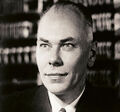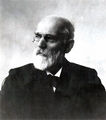Template:Selected anniversaries/March 8: Difference between revisions
No edit summary |
No edit summary |
||
| Line 21: | Line 21: | ||
||1848 – LaMarcus Adna Thompson, American engineer and businessman, developed the roller coaster (d. 1917) | ||1848 – LaMarcus Adna Thompson, American engineer and businessman, developed the roller coaster (d. 1917) | ||
||1853: Edward John Dent does ... clockmaker and inventor whose chronometers were noted for high accuracy. His patents in this field included compasses for navigation and surveying. He experimented with springs made of steel, gold and glass, and devices for counteracting the effects of temperature change upon timepiece mechanisms. As clockmaker to Queen Victoria, he was commissioned to build the Great Clock for the clock tower of the Houses of Parliament (known as Big Ben, although that is actually the nickname of its hour bell) which he began in the year he died. His son, Frederick Dent, completed the work the following year and it was installed in the tower in 1859. It continues to be recognised for its great accuracy of 4 seconds in a year. Pic. | |||
||Ernest Vessiot (b. 8 March 1865) was a French mathematician. Vessiot's work on Picard–Vessiot theory dealt with the integrability of ordinary differential equations. Pic. | ||Ernest Vessiot (b. 8 March 1865) was a French mathematician. Vessiot's work on Picard–Vessiot theory dealt with the integrability of ordinary differential equations. Pic. | ||
Revision as of 17:05, 15 August 2018
1618: Mathematician and astronomer Johannes Kepler discovers the third law of planetary motion.
1618: Mathematician and crime-fighter Galileo Galilei prevents alleged supervillain Anarchimedes from assassinating astronomer Johannes Kepler. Anarchimedes intended to steal credit for discovery of the third law of planetary motion.
1775: An anonymous writer, thought by some to be Thomas Paine, publishes "African Slavery in America", the first article in the American colonies calling for the emancipation of slaves and the abolition of slavery.
1822: Pharmacist, inventor, and industrialist Ignacy Łukasiewicz born. He will build the world's first oil refinery and invent the kerosene lamp.
1840: Physicist, chemist, and crime-fighter Hans Christian Ørsted uses magnetic fields created by electric currents to detect and prevent crimes against physical constants.
1879: Chemist and academic Otto Hahn born. He will pioneer the fields of radioactivity and radiochemistry, winning the Nobel Prize in Chemistry in 1944 for the discovery and the radiochemical proof of nuclear fission.
1900: Physicist and computer scientist Howard H. Aiken born. He will design the Harvard Mark I computer.
1901: Mathematician and philosopher Georg Cantor uses set theory to detect and prevent crimes against mathematical constants.
1914: Physicist, astronomer, and cosmologist Yakov Borisovich Zel'dovich born. He will play a crucial role in the development of the Soviet Union's nuclear bomb project, studying the effects of nuclear explosions.
1923: Theoretical physicist and academic Johannes Diderik van der Waals dies. He won the 1910 Nobel Prize in physics for his work on the equation of state for gases and liquids.
1927: Mathematician Karl Menger publishes new class of Gnomon algorithm functions which which generate stochastic preventive algorithms in response to crimes against mathematical constants.
1933: Ready Kilowatt performs in off-Broadway adaption of Reddy Kilowatt Versus the Travelling Salesman Problem.











